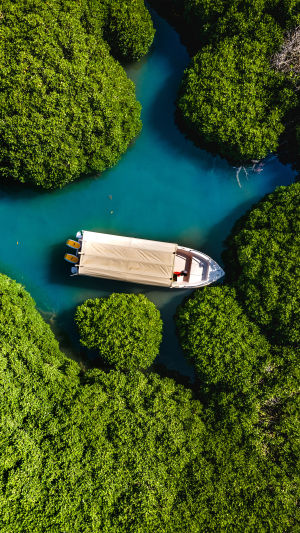Off the coast of the southern province of Jazan, there is a small group of coral islands called the Farasan Islands.
With its idyllic white coastline and historic, well-preserved pristine landscapes, this island paradise offers relaxation, austerity, and the chance to dive and snorkel in the Red Sea.
There is evidence of human activity here as early as the first millennium BC. Historically, people who have left the footprints of civilization here include the Sabaeans, Romans, Axumians, Ottomans, and of course the Arabs. Don't forget to visit the unique house built with coral on the main island.
But Farasan may not be best known for its human history. On the contrary, as a marine protected area, the biodiversity here is incredibly rich.
First of all, the islands are best known for their mangroves - which are breeding grounds for a large number of birds.
and the adjacent marine feeding grounds also attract a variety of birds such as ospreys, smoke falcons, pink-backed pelicans, Red-billed pheasants, white-eyed gulls, Sanders' lesser terns, crab plovers, and even flamingos. Some islands are even home to the endangered Farasan gazelle, and it is rare to see one!
Beneath the waves that lap the island's shores lies a coral system that remains unexplored. It's up to you to discover the untapped potential of this ocean world! Farasan is best known for its brightly colored parrot fish (which locals hold a festival every spring).
From whale sharks and dugongs to sting rays and turtles, the underwater world here is endless. Be sure to stop by Jizan Harbor to browse the many dive shops, book boats, guides, and launch gear!
The Farasan Islands offer a rustic escape from the hustle and bustle of the city, and experienced guides can help you better navigate its borders. But if you want to plan your adventure, there are multiple daily ferries to take you to and from the island. You pack your bags and gear!
The mangrove forest on Farasan Island is a unique ecological feature. Mangroves are salt-tolerant trees and shrubs that grow in coastal areas with brackish water. They serve as important ecosystems, providing a habitat for various marine species, acting as nurseries for fish, and protecting coastlines from erosion and storm surges.
The presence of a mangrove forest on Farasan Island indicates the significance of the island in terms of biodiversity and environmental conservation. Mangroves play a crucial role in maintaining the balance of coastal ecosystems and are vital for the overall health of marine environments.





